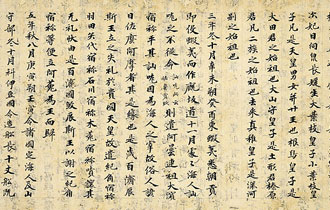Pages |
So, when it comes to learning Japanese, the learner must learn a new set of appropriate linguistic and non-linguistic behavior that is based on different cultural assumptions, values, and expectations in order to become an unobtrusive user of the language. Second, learning certain words of behavior appropriate for living in Japan goes hand in hand with learning Japanese. Furthermore, being culturally attuned to Japan involves not only learning to behave appropriately but also learning about Japanese history, people, and society.
In the case of France, many of us are already familiar with its history. One knows what the French Revolution was about. But can we assume the same level of knowledge about Japan? Does the Meiji Restoration resonate among Americans the same way that the French Revolution does? In learning language, and theorizing about language, one needs to be alert to the fact that language does not exist in a vacuum; language is meaningful only when it is understood in the web of connections with its people and culture, its present and past. To learn Japanese, then, is to become fluent with Japan's cultural codes and to learn the connections that are there now as well as those that lead one back to its historical past.
The third factor having an impact on the difficulty of learning Japanese is the writing system. In addition to the typological features of Japanese and the cultural distance between Japan the United States, many believe that the writing system constitutes a major hindrance to the learner of Japanese. A typical student studying a commonly-taught language can instantly benefit from his/her knowledge of the English alphabet and can guess at the meaning of a word written in that alphabet. The writing system is familiar and the usefulness of a shared alphabet is undeniable. The Japanese writing system however consists of two sets of mora-based symbols, roughly one for each moraic unit, called hiragana and katakana--used more or less systematically for different purposes. Japanese also uses two thousand or so (for basic adult literacy) kanji characters borrowed from Chinese. In contrast to Chinese, in which a character is associated with only one pronunciation, a kanji may be pronounced in a number of ways, depending on the context in which it appears. Japanese children spend thousands of hours learning both how to write the characters and how to identify which sounds a given character gets at a given time. More than 1/4 of the total class time in elementary school education is devoted to teaching children how to read and write. If a student of Japanese in the United States would like to learn to read even a simple Japanese newspaper article, he should know what kind of challenge this entails.
To make matters even more difficult, a Japanese text may be written in two orientations. A newspaper article may be read vertically, starting from the right uppermost corner of a text, reading down to the bottom of the line, then moving to the next line to the left. Other texts are printed so that they are meant to be read horizontally, much like an English text. Usually texts in the literary genre are written vertically, while those in the social and natural sciences are written horizontally. Books open left to right and read like an English book if the text is written horizontally, but they open and read from right to left if the text is printed vertically. In some publications in which texts of both types need to be merged into a single book, the book might have two sections—one for a horizontal text, which reads like a regular English book, and another for vertical texts, which reads from the opposite end. For the uninitiated, this is certainly confusing.
Pages |











